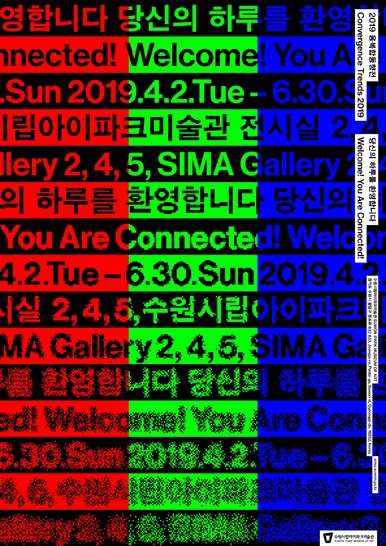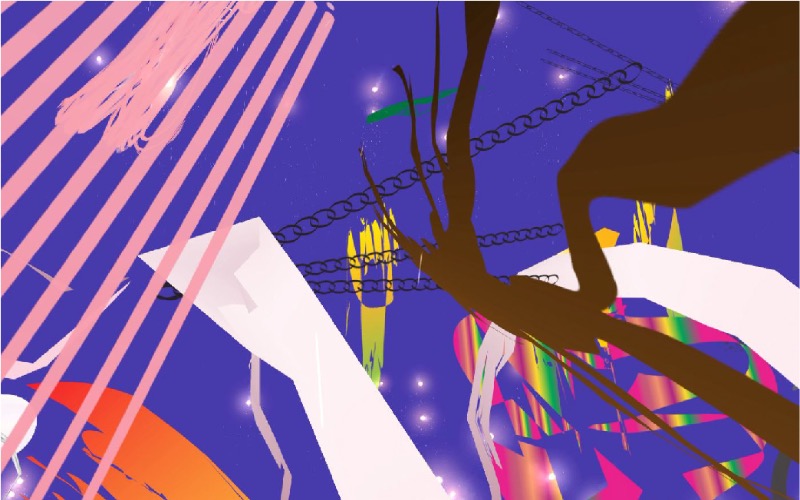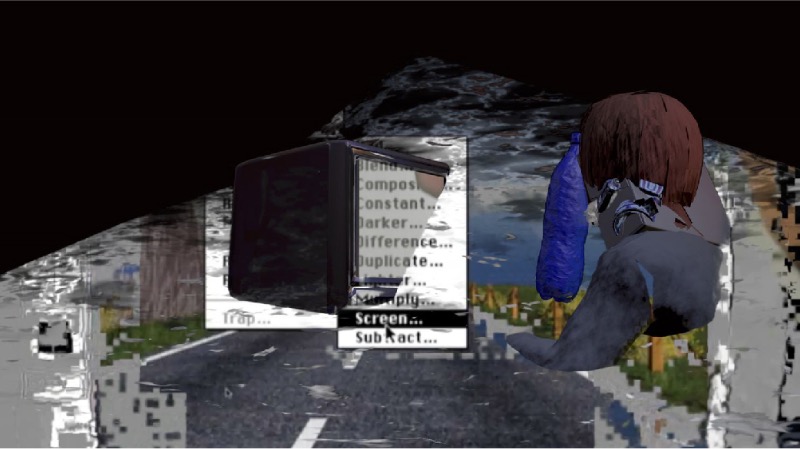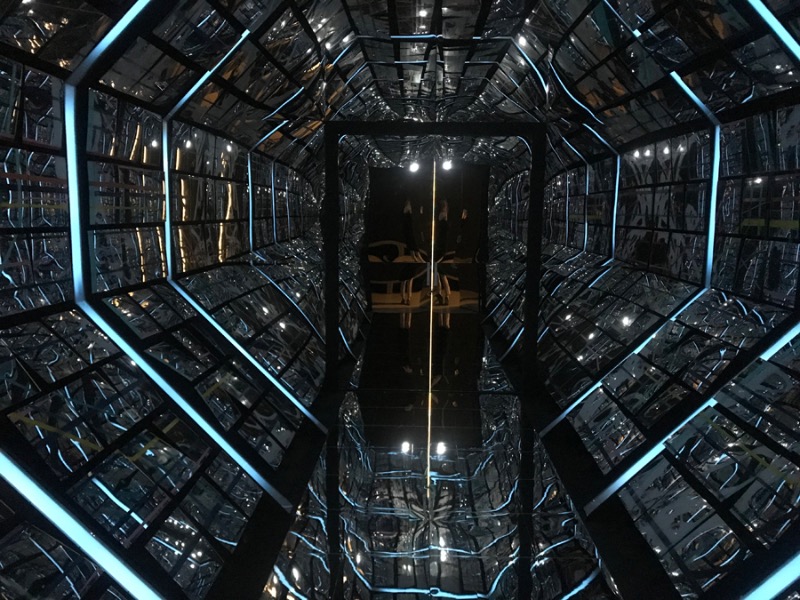
| Period| | 2019.04.02 - 2019.06.30 |
|---|---|
| Operating hours| | March-June 10am - 07:00pm |
| Space| | Suwon Museum of Art |
| Address| | 833, Jeongjo-ro, Paldal-gu, Suwon-si, Gyeonggi-do, Republic of Korea |
| Closed| | Monday |
| Price| | 4,000 won for adults / 2,000 won for students / 1,000 won for children |
| Phone| | 031-228-3800 |
| Web site| | 홈페이지 바로가기 |
| Artist| |
안가영,오택관,료이치쿠로카와
|
정보수정요청



|
|
Exhibition Information




"I log on. It exists." "I Am Connected Therefore I Am." Welcome to your day, the first exhibition of the year at Suwon I'Park Art Museum.》 connects to the digital network 24 hours a day and shows a modern person who can exist only when he constantly consumes images and information handed over by computers and smartphones. The world of networks has not only removed the boundaries between space and time, but also destroyed the distinction between virtual and real life. In this infinite space, we communicate with others anytime, anywhere, and easily create my own identity and personality that is different from the real world. The reality and satisfaction of the virtual world created by 0 and 1 are sometimes more intense than that of the real world, and the network has made a big difference in its existence style, way of perception, and sensitivity. Welcome to your day (Welcome! You Are Connected!) is a metaphorical representation of a modern person who can exist in the real world only when connected to such a virtual network. Writers Ahn Ga-young (1985), Yeom Ji-hye (1982), Oh Taek-gwan (1980), Yoon Hyang-ro (1986), Lim Young-joo (1982), Lim Bong-ho (1984) and Ryoichi Kurokawa (1978) who participated in the exhibition, will compile images circulating in the network and interpret their unique visual expressions of relationships within the digital society. Twenty-one works by participating artists (including two series) will be presented in exhibition halls, 2, 4, 5 and exhibition halls. In 'The Box of Hermes (2018), Ahn Ga-young shows how information is transformed and propagated over the Internet in the form of a 3D game. Through "The Manners of Potoshopping Life (2017), Yeom presents a uniform and repeated life style of modern people through visual works, such as "copy" and "ctrl+v," a function of graphic tool Photoshop. And Oh Taek-kwan's <Front Space (2019) is a motif-winning work from Stanley Kubrick's film "2001 Space Odyssey" that reflects our daily lives as one, feeling the two worlds that have been/offline and digital/analogically contrasted with mirror panels installed on every side of the enclosed room. Yoon Hyang-ro proposes a new form of painting that replicates-reconstructs images from digital media through the 135 series <Blasted (Land) Scape (2019], which has been extracted and transformed from a comic book and recreated. Lim satirizes the reality that false information is accepted as true when repeatedly circulated through experiments using natural materials such as stones and wind in Test_ Material (2016), Stone (2016), Wind (2016), and Text_Power (2016). Lim Bong-ho suggests that visitors stand directly on the installation work of a three-channel video, 'Buddha_2' (2019), and look at the problem of various information contained in the digital world from an objective perspective. Finally, in Ground (2011), Ryoichi Kurokawa portrays the violent nature of the world by slowly transforming and distorting still photographs of the pain and tragedy of war into lyrical painting images. To make the exhibition easier to understand, there is an archive room where each writer can ask questions and search for interview videos and artwork-related archives of his or her own by using his or her cell phone. The booth will also provide visitors with a chance to experience the production of Internet broadcasting on a regular basis. It will also run an exhibition-linked education program that invites one-man media creators who are active on YouTube during the exhibition. ■ I-Park Art Museum in Suwon Yeom Ji-hye (b. 1982~) Yeom Ji-hye notes the culture of a particular place of the individual, the relationships with people and the common experience of the contemporaries. And look for a link between work in a mix of images expressing the past and the present, today and the future, experience and memory, images and dreams, legends and narratives, and deals with what seems to be accidental. The writer values the sound and narration of the video, which can be felt through the appreciation of the work. In addition, the writer places importance on the art and space, the relationship between the work and the audience, by organizing the screening method and installation of the work video differently according to the exhibition. The Porto-Shopping Manners (2017) is the last chapter of the three-chapter Current Layers. The Current Layers (2017) stands for the things that have been built up to make up our present society, and shows us the way and form of our lives, past, present and present on earth. The other two chapters show changes in life from the geologic era to the plastic, and finally, from the Potoshopping Manners, change in human cognition. <Life in Layers>(2017) repeatedly plays some of the scenes in <Porto-Shopping Manners>. Through his work, the author describes a uniform and repeated way of life of modern people, such as "ctrl+c" and "ctrl+v" of the computer graphic program Photoshop. Ahn Ga-young (b.1985~) Attention to the unexpected fun and errors caused by the meeting of humans and something in digital life in the digital age, and express this as a work combining games and art. The Hermes Box (2018) introduced in this exhibition shows how information is transformed and disseminated in the process of collecting information on the Internet. Visitors help Hermes escape through digital games that collect three kinds of hidden items, and analog games that control the terrain of maze with boxes in the exhibition hall. Visitors teleport between online and offline with Hermes, exploring the digital landscape that is fraught with pleasure, truth, disgust and errors. Finally, Hermes, who escaped the maze of the network and arrived at the goddess hash (#), finds that the same time has passed as when he made the shortcut. However, as he wandered through the maze, the contents of the box changed, which only the goddess hash (#) can tell. Indeed, our small online activities are only slightly moving around the world, just as they translate into data and create another big data. Oh Taek Kwan (b.1980~) Author Oh Taek-kwan deals with the changing urban and contemporary image of the digital world, where communication and sharing of information across time and space are free. The author expresses it in a rhythmical way in geometric lines and faces, fragmented shapes and contrasting colors. The "Frontspace" (2019), which will be introduced in this exhibition, will reflect our daily lives as one feels in two worlds, online, offline, digital, and analog. It is the second installment of the "Frontspace" series, which was designed with motifs in the 2001 Space Odyssey (1928-1999) film by Stanley Kubrick. The writer intersected the city's fragmented image on mirror panels installed on all sides of the enclosed room and continued to overlay the new image. Visitors can feel a twist as they enter the room from a routine space, and experience a vision in which pieces of paintings unfold in a zero-gravity space. By doing so, the writer wants to show beyond the limits of the floor plan, not the visible space. Yoon Hyang-ro (b. 1986~) The author reproduces, disassembles, or reconstructs images of mass media and expresses them on canvas or screen to tell the life of modern people. The author draws images from cartoons and animations and changes them into computer programs again in paintings on canvas. These works turn into abstract paintings, which cannot be seen as traces of cartoons. The new series "Blastened (Land) Skape" (2019) looks similar, but there are fine differences as if they follow a certain order. Visitors can find familiar and unfamiliar images in these works, such as dots, contours, traces of motion, explosions, flowers, liquids and airflow. It digitized comic books through scanners and edited them by using computer graphics programs such as Photoshop, Indy, and so on, leaving only certain parts such as sparks, motion lines, and background lines. And the edited images were completed with multiple layers of overlapping work. A number, such as a code for a title of a work, means the number of layers used to produce a work. They were then printed using inkjet printers that were long-lasting and capable of high-resolution output. In this way, the author digitally removed only the characters and edited and reconstructed the remaining scenes to create another landscape, such as landscape paintings. Lim Young-joo (b.1982~) The author makes works by combining the realm of superstition and religion with science in various media such as video, painting, installation and publication. The author cites the fate of today's hit rate and the weather, the news report that says it is safe from radiation from Japan due to the influence of "written winds," the unfamiliar word "bulgo dog" that occurs if one does not write "I will be a Buddhist dog," and the scientific legend of "Yojeong," which refers to the stone as "a revelation of the universe" away from the sky. The exhibition's Test_Materials (2016), Stone (2016), Wind Power (2016), and Test_Power (2016) are the subjects of the nature of the stone, wind, and so on. The works are videos showing hands on stones heated with alcohol lamps, micro-containing the sound of rubbing stones inside the stone and holding balloons with clay. It seems like a scientific experiment, and it seems static and stopped, so it feels like a meditation. The title "The Gun Gun" (2017), another work of the exhibition, also means "a word that ends in a letter" that looks "close and many stars clearly." the author is Han Lim Young-joo (b.1982~) The author makes works by combining the realm of superstition and religion with science in various media such as video, painting, installation and publication. The author cites the fate of today's hit rate and the weather, the news report that says it is safe from radiation from Japan due to the influence of "written winds," the unfamiliar word "bulgo dog" that occurs if one does not write "I will be a Buddhist dog," and the scientific legend of "Yojeong," which refers to the stone as "a revelation of the universe" away from the sky. The exhibition's Test_Materials (2016), Stone (2016), Wind Power (2016), and Test_Power (2016) are the subjects of the nature of the stone, wind, and so on. The works are videos showing hands on stones heated with alcohol lamps, micro-containing the sound of rubbing stones inside the stone and holding balloons with clay. It seems like a scientific experiment, and it seems static and stopped, so it feels like a meditation. The title "The Gun Gun" (2017), another work of the exhibition, also means "a word that ends in a letter" that looks "close and many stars clearly." The author gave a cosmic imagination within the two meanings of a word. In this way, he expressed a meeting between the two worlds that seemed irrelevant, like science and religion. Lim Bong-ho (b.1984~) Author Lim Bong-ho deals with language that can be met in everyday signboards, leaflets, books and conversations. The author thinks that there is a hidden meaning in the language and expresses it in the works using various media. Through this, the author talks about the hidden phenomenon of various information in the digital world and allows modern people living today to look at information from an objective perspective. Visitors on the podium to appreciate the exhibition's <Buddha_2> (2019) will be surrounded by applause and sounds played from all sides. Sound accumulates in the course of video playback and replacement. Visitors will find it difficult to recall from the sounds of applause, which overlaps with the traditional words of applause, cheering, sympathy and ridicule. In addition, the author takes the title from the paja form of '붙' and recalls other words such as '부,' '딪,' '부,' and '破字.' This allows visitors to interpret the title of the work "Buddha" autonomously. Another work, <effective Amount_2> (2019), consists of visitors participating in card games. The author wrote down the words he chose through a web search on the card and expressed them on behalf of Trump's style in color and font. Visitors will play the game based on the rules they already know or the minimum rules suggested by the writer. The author makes the audience watch and think for themselves what cards they take and throw away through the game. Ryoichi Kurokawa (Ryoichi KUROKAWA) (b.1978~) The writer is a digital artist based in Berlin, Germany, who has been setting up media, producing and announcing sculpture on stage around the world since 1999. The writer lyrically recreates the analogous appearance of nature, the source of inspiration, as a symphony through digital technology. It also interprets and describes the laws in which order is made and the forces of energy. The relationship between time and space as well as between analogue and digital, the whole and cross-section, simplicity and complexity, response and coordination, and hearing and vision are important factors in the author's work. In the exhibition's Ground (2011), the author expressed nature, which is suffering from violence. It was inspired by a warring battleground in the video of Belgian journalist Daniel Demostier and a conflict in southeastern Europe. The three images on the screen depict different perspectives on different battlefields and disputed areas. And it stimulates visitors' feelings by showing the pain and tragedies that took place there. Still images appear in a dynamic sequence that is indistinctly extended and varied from one motion to another. The flow of long, slow scenes increases the pressure of visitors, and the slow transformation of images makes the image feel as if it were stopped. The author selects and arranges images and sounds that do not follow the passage of time, making it impossible for visitors to imagine the situation before and after even seeing images of war in the video.
